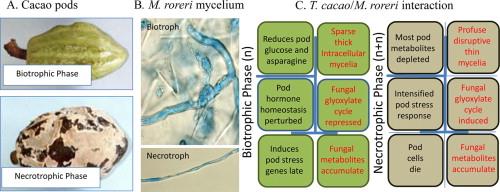Dynamic changes in pod and fungal physiology associated with the shift from biotrophy to necrotrophy during the infection of Theobroma cacao by Moniliophthora roreri |
| |
| Affiliation: | 1. Sustainable Perennial Crops Laboratory, Plant Sciences Institute, USDA/ARS, Beltsville Agricultural Research Center-West, Beltsville, MD 20705, USA;2. CABI Caribbean & Latin America – CATIE Office, Centro Agronómico Tropica de Investigación y Enseñanza (CATIE), 7170 Turrialba, Costa Rica;3. Crop Systems and Global Change Laboratory, Animal and Natural Resources Institute, USDA/ARS, Beltsville Agricultural Research Center-West, Beltsville, MD 20705, USA;4. Laboratório de Genômica e Expressão, Departamento de Genética, Evolução e Bioagentes, Instituto de Biologia, U. Estadual de Campinas, CEP 13083-970, Campinas-SP, Brazil;5. Department of Horticulture, The Pennsylvania State University, University Park, PA 16802, USA;1. Universitätsklinikum Gießen und Marburg GmbH, Marburg, Germany;2. Max-Planck-Institut für Biophysik, Frankfurt am Main, Germany;1. Instituto de Ciências Agrárias e Ambientais Mediterrânicas, Instituto de Investigação e Formação Avançada, Universidade de Évora, Núcleo da Mitra, Ap. 94, 7006-554 Évora, Portugal;2. Departamento de Fitotecnia, Escola de Ciências e Tecnologia, Instituto de Ciências Agrárias e Ambientais Mediterrânicas, Universidade de Évora, Núcleo da Mitra, Ap. 94, 7006-554 Évora, Portugal;1. Laboratory of Zoology, University of Yaoundé 1, Cameroon;2. World Cocoa Foundation, Accra, Ghana;3. International Centre of Insect Physiology and Ecology (ICIPE), Nairobi, Kenya;4. Food Security and Safety, Faculty of Agriculture, Science and Technology, North-West University, Potchefstroom, South Africa;1. Agricultural Research Station Banswara, Rajasthan, India;2. Rani Lakshmi Bai Central Agricultural University (RLBCAU), Jhansi, U.P, India;3. SKN College of Agriculture, Jobner, Rajasthan, India;1. Institute of Plant Molecular and Developmental Biology, Heinrich-Heine-University, Universitaetsstrasse 1, 40225 Duesseldorf, Germany;2. Cluster of Excellence on Plant Sciences ‘From Complex Traits towards Synthetic Modules’, 40225 Duesseldorf, Germany;1. Metav-CD, 31C.A.Rosetti st,.Bucharest 021011, Romania;2. University Politehnica of Bucharest, Department of Strength of Materials, Splaiul Independentei 313 Bucharest 060042, Romania;3. University Politechnica of Bucharest, Department of Metallic Materials, Slaiul Independentei 313, Bucharest 060042, Romania |
| |
| Abstract: | 
Theobroma cacao pods were inoculated with meiospores of Moniliophthora roreri (Mr), a hemibiotrophic basidiomycete causing frosty pod rot. Pods were malformed 30 days after inoculation (DAI) and sporulation was observed 60 DAI. Glucose and asparagine concentrations decreased and mannitol and malonate increased in infected pods 30 DAI. By 60 DAI, most carbohydrates, amino acids, and organic acids were drastically reduced by infection. Mannitol and succinic acid levels increased 60 DAI and likely originated from Mr. RT-qPCR analysis of cacao ESTs indicated a strong response to infection 30 DAI in malformed pod. Evidence indicated that biotrophic hyphae colonized pods and a shift to necrotrophic growth occurred later (during the end stages of infection). Expression of cacao ESTs associated with plant hormone biosynthesis and action was altered. Changes in the expression of Mr ESTs in response to nutrient deficiency in pure culture were small. Changes in Mr gene expression patterns and levels of specific metabolites in necrotic sporulating pods 60 DAI compared to malformed pods 30 DAI indicated that the glyoxylate cycle of Mr was up regulated during the shift from biotrophic to necrotrophic phases of the disease cycle. |
| |
| Keywords: | |
| 本文献已被 ScienceDirect 等数据库收录! |
|

